イン フォーカスIN FOCUS
日本語は こちら
 in FOCUS
in FOCUS
きれいな大きな目とは
What are Bigger Beautiful Eyes
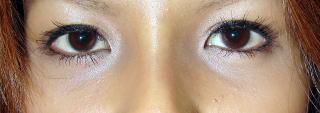
From the East to the West, or maybe around the world, bigger eyes are more appreciated than smaller ones.
Especially in Japan、and to the rest in Asia, where the sizes of the eyes are relatively smaller than the Westerners', the pursuit of becoming someone with noticeable eyes is a very common thing.
Even Westerners tend to like bigger eyes、not to mention younger people、and most commonly observed in the aging society which is much bothered with droopy eyelids that consequently make eyes look tinier.
Furthermore, this trend appears on statistics of cosmetic care provided around the world, showing Japan having eye cosmetic care as the number one in mostly performed procedures, in the States the second mostly acquired care, just after cosmetic care for the body.
Besides being favored as beautiful outward aspects, bigger eyes also give younger looks, and also let one able to express oneself more of inner feelings and emotions during direct contact with others.
Even in a calm facial expression a person with smaller eyes sometimes humiliates others, giving impressions that that person is always angry of something、making this a very common complaint cosmetic surgeons hear from patients seeking help for their small eyes.
The point is, eyes tell all about one's self, and the bigger the eyes the more they can tell about the possessor.

Bigger eyes are not always attractive.
In a widely opened eye, the exposed iris(the colored portion of the eye)that slightly touching or barely hiding along the eyelids' edges is commonly presumed a feature of a naturally beautiful eye, while an eye with iris that shows wholly or more is more like a ’frightened or feared eye’ that is not considered beautiful.
From here, while exploring the techniques of how to make eyes bigger, we further discuss details about what beautiful eyes should look like:
1.Buried Suture Method Blepharoplasty Buried Suture Method Blepharoplasty or Non-surgical Eyelid Lift, is a procedure of widening upper eyelid folds for the purpose of making the eye bigger or look bigger.


before suture method after suture method
downtime: swelling/tenderness few days to 1 wk., if bruise noticed, needs 1to2 wks.
Suture Method is a technique born in Japan in 1920. For almost 100 years it has played a significant role in cosmetic field of the country.
Nowadays it changes into various names(such as quick something method, natural something folds, etc.) that cause some confusions, but basically they are Buried Suture Methods that use nondissolvable nylon threads that sew the front and back of the upper eyelid together to create a new fold or widen the narrow one.
Currently the superfine threads particularly used in microvascular surgeries are applied to this procedure and bring out remarkable outcomes.
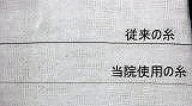
usually used 8-0 nylon
nylon used in microsurgery
'Petit Seikei or Petit Cosmetic Surgery' is a very common slang circulating around Japan now, which refers to instant cosmetic jobs that do not need any knives, and the actual original 'Petit Seikei' is this method, the Buried Suture Upper Blepharoplasty.
After 100 years, uncountable improvements have been considered to deal with the issue of how to make this thing long-lasting.
Many approaches have been made to tackle this problem such as increasing the number of threads used or modifying the knots made when binding, but still these are all unclear to most patients whether they are helpful or not.
The number of threads needed to make a fold on one eyelid is 1 to 3, and the more threads are used the stronger the support to hold is.
Some think of going for 4 or more threads, but this is not advisable because the area to suture on the lid is not wide enough to accomodate 4 or more sutures.
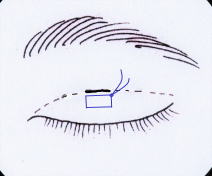
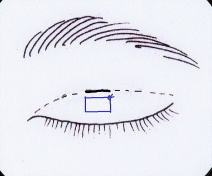
1 thread
before/after burying
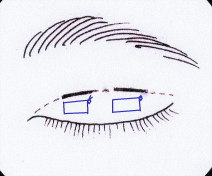
2 threads
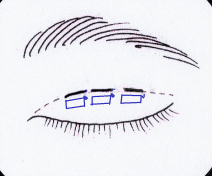
3 threads
The way of tying the lid tissue is basically done as shown above, in a rectagular or square manner to bind the subcutaneous layer(under skin layer)and the tarsus(cartilage sheet at the lid back)in order to hold the levator aponeurosis(tendon), which is necessary to produce a new fold.
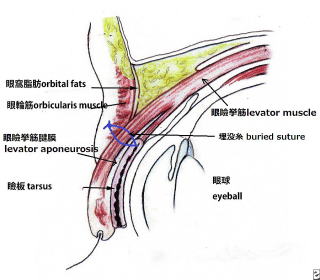
In any case, since buried sutures do not last permanently、fold lines may fade away、and sometimes even without the help of a suture, a crease might be produced permanently as a consequent of long holding by the thread.
To have a stronger hold of the fold, upon increasing the number of threads, tying the thread to the adjoining one together helps to strenghten the bond and makes a long-lasting fold.
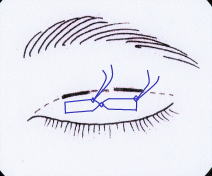
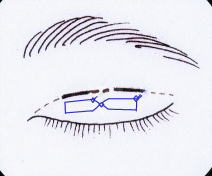
2threads connected
bef/after burying
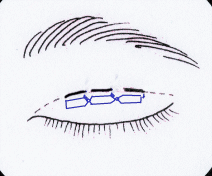
3threads connected
Folds produced by Buried Suture Method have natural appearance and do not give you the 'frightened or fearful looks''.
Beside that, a naturally created fold itself also is recognized as a part of the eye size making the eye looks bigger, the reason why this procedure shows a dramatic outcome even with its simple process that lasts only around 5 minutes.
However, when the fold line is made on the unnaturally high or wide level, the eye will not open widely, it contradictionally looks smaller, and the fold on it looks like another thing that is hard to discern as a part of that eye.
This is the state the eyes look unnaturally drowsy, and eventually the created folds tend to fade easily or fast.


before buried suture after buried suture
downtime: swelling/tenderness few days to1 wk., if bruise noticed, needs 1to2 wks.
Natural folds should be around 20 to 30% of the actual eye vertical width.

Buried Suture Blepharoplasty is capable of making not only new folds but also widens narrow folds and also tucks excess skin to a new level to resurrect younger beautiful eyes.
2.Incision Upper Blepharoplasty While Suture Method makes eyelid folds with sutures, Incision Upper Blepharoplasty or Surgical Eyelid Lift creates folds by allowing eyelid muscles to stick to each other with the help of the incised wounds.
Wound scars hide deep in the crease when the eyes are open and later on remain unnoticeable even when eyes are closed.
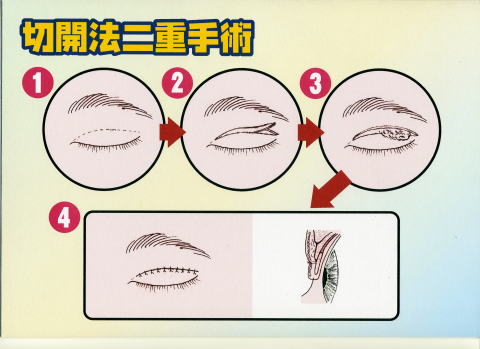
incision method illustration
By this procedure, bulging excess fats and saggy skin can be removed, making the eyes look fit or well-shaped ,and of course, bigger.


before incision after incision
downtime: swelling&bruises for 1to2 wks., puffiness&overdone looks for around 2 mos.
Definite benefits gained from Incision Blepharoplasty, which are quite different from what are seen after Suture Method, are the long-lasting and mostly permanent fold lines.
This method is the first choice for cases that are bothered with saggy excess skin.
Disadvantages include long downtime, which is precisely not in the same level with the 1-week slight swelling of the Suture Method, in Incision Method that takes 2 weeks of severe swelling and later change into months of discomfort with appearance not to mention the feeling of heaviness on the upper lid. This, of course, is certainly affected by the desired width of the fold. Narrower lines show less swelling and discomfort that can soon be covered with make-up, while wider folds display opposite situation.


just after incision 1 month later
downtime: swelling&bruises for 1to2 wks., puffiness&overdone looks for around 2 mos.
Another disadvantage appears when fold lines are done on overly wide levels, in which eyes will not open widely and show unnatural larger folds for a long period or maybe permanently and require another repairment surgery that must be done after months of waiting, while Suture Method will just subside by itself and if not, Suture Method stitches can be replaced easily as repairment.
3.Inner Canthoplasty(Epicanthoplasty) If Blepharoplasty(Eye Lift) is good for widening vertical palpebral fissure(length between opened upper&lower lids), Canthoplasty is for lengthening horizontal length. Epicanthoplasty(Inner Canthoplasty) is the procedure of choice in widening horizontal length, and this enlarges inner corner of the eye.
It enlarges eyes by removing the Mongolian Folds, the folds that hide the inner angles of the eyes.
Uchida Method was the popular basic method when canthoplasty was beginning to break out, a method that displace the Mongolian Fold by a W shaped incision.
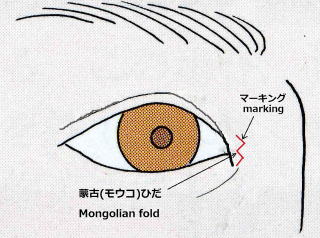 Uchida Method marking
Uchida Method marking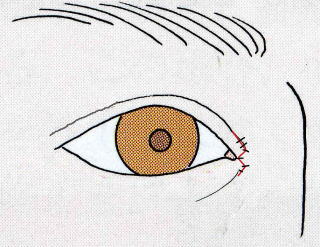 after surgery
after surgeryRecently, Modified Uchida Method is getting more popularity.
The lower half of the W is simplified to minimize wound scar.
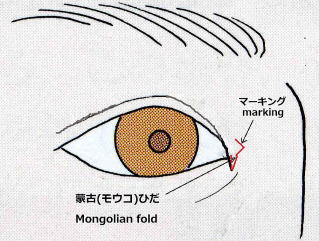 Modified Uchida marking
Modified Uchida marking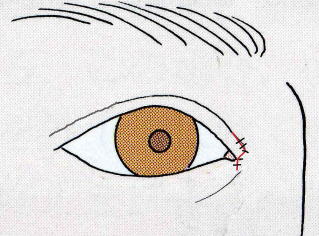 after Modiified Uchida
after Modiified UchidaInner Canthoplasty does not only enlarge the actual inner corner of the eye but also widens inner edge of the upper eyelid fold line, making it parallel to the lid edge line.
By this effect, the eye opening is more emphasized, making it look more bigger and bright.
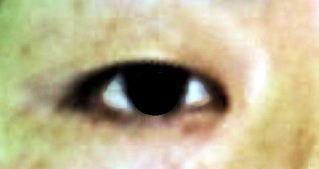 before epicanthoplasty
before epicanthoplasty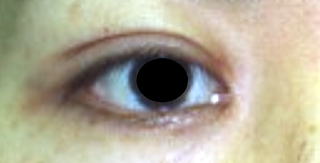 after epicanthoplasty
after epicanthoplastydowntime: swelling&bruises take about 1 wk., wound redness lasts about 1to2 mos., coverable with make-up
In Inner Canthoplasty, the following 2 precautions must be considered:
・Scar recovery varies in every individual. Only few weeks are needed for a person who has the outstanding recovery to see an outstanding fading of the scar, while some who have issues with scar healing might have to see years to observe fair healing.
・Removed Mongolian Folds skin cannot be revived. It is almost impossible to return to the previous you. Especially when fold lines are paralleled, a considerable change in image can be observed from the outcome that might bother some patients and also sometimes worsen the length between eyes that originally have a short gap. So consideration of these factors is a must before the treatment.
4.Lateral Canthoplasty Lateral Canthoplasty is the lengthening of the opposite edge of the eye where epicanthoplasty is done.
To be specific, Eye's outer edge is simply incised in horizontal slit and then trimmed accordingly to the shape of the palpebral fissure(edges of open upper and lower lids).
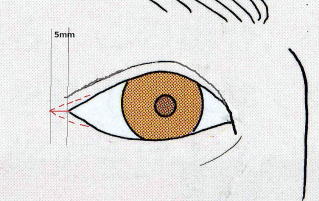 lateral canthoplasty marking
lateral canthoplasty marking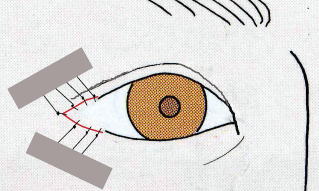 after lateral canthoplasty
after lateral canthoplastyStitches are cut longer, then stretched for almost 1 week in vertical direction with tapes.
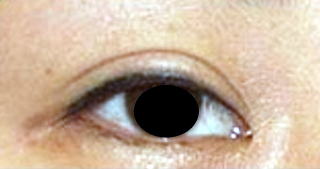 before lateral canthoplasty
before lateral canthoplasty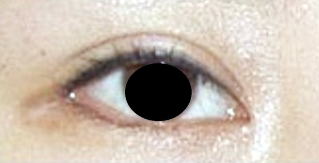 after lateral canthoplsty
after lateral canthoplstydowntime: swelling&bruises take 1to2 wks. to recover, wound scar is not that obvious but 1 wk. of taping needed
Excess saggy skin of the upper lid usually disturbs effect of canthoplasty, so conjunction with Upper Blepharoplasty is necessary for such cases.
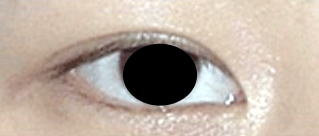 before lat. canthoplasty+incision bleph.
before lat. canthoplasty+incision bleph.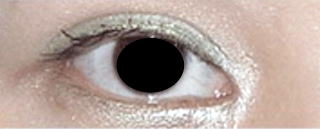 after lat. canthoplasty+incision bleph.
after lat. canthoplasty+incision bleph.downtime: swelling&bruises take 1to2 wks. to recover, wound scar is not that obvious but 1 wk. of taping needed
Even without skin issues, widening of the outer edge of folds with blepharoplasty helps lateral canthoplasty to express better effects.
Especially in upper lids with obvious fats, eye's outer edge tends to be hiden by this feature and certainly needs elevation with blepharoplasty.
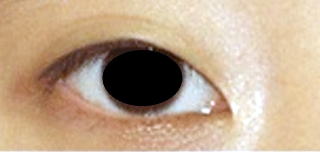 before lat. canthoplasty+suture bleph.
before lat. canthoplasty+suture bleph.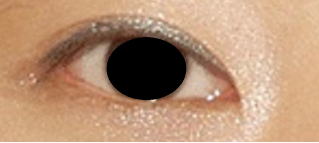 after lat. canthoplasty+suture bleph.
after lat. canthoplasty+suture bleph.downtime: swelling&bruises take 1to2 wks. to recover, wound scar is not that obvious but 1 wk. of taping needed
Lateral Canthoplasty is not as effective as Inner Canthoplasty, but wound scar healing is not that bad, so returning to daily routine and observing a natural effect is faster.
5.Ptosis Repairment Bigger eyes can be attained by blepharoplasty, is the theme of the statement above.
Unfortunately, eyelid that cannot be lifted with blepharoplasty does exist as an abnormality caused by dysfunction. Being not able to produce folds means that that eye cannot be enlarged. This condition is called ptosis, upper eyelids not opening up by itself, leaving eyes look unattractively small.
 left ptosis
left ptosisPtosis is not a disease name but a symptom caused by various diseases and injuries which have different period of onsets that are the reason of a complicated naming of the kinds.
But from here explanation of the complicated types is omitted, and let us just focus simply in the symptom.
When levator muscle(muscle that lifts eyelid) does not function well, eye opening becomes limited which is called ptosis.
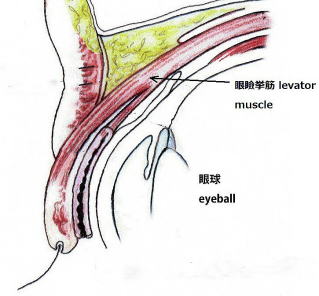
dysfunctional levator muscle
Ptosis observed in relatively young case is usually unilateral or one-sided, unevenness is quite obvious that the patient is much bothered with its cosmetic concerns beside other discomfort such as upper lid heaviness or narrowed visual field.
Repairment(which is called Levator Advancement) is usually done just at the affected side.
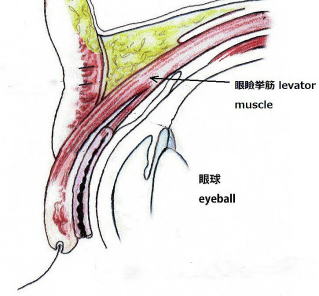
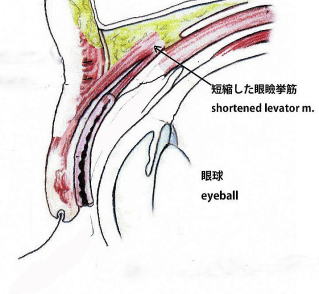
dysfunctional levator muscle shortened levator muscle
Dysfunctional levator muscle or its aponeurosis(tendon) is folded and shortened , then eyelid fold is made to lift the eyelid.


before ptosis repair after ptosis repair
downtime: swelling&bruises for 1to2 wks., puffiness&overdone looks for around 2 mos.
Ptosis seen in the elderly(senile ptosis) usually is bilateral and most of the time is combined with saggy excess skin which requires removal and eyelid lifting(blepharoplasty) together with Ptosis Repair.
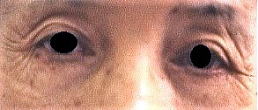
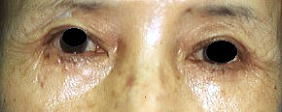
before repair after repair
downtime: swelling&bruises for 1to2 wks., puffiness&overdone looks for around 2 mos.
Even in cases without ptosis but want to enlarge eye sizes but not with eyelid folds, Levator Muscle Advancement is effective, but not a procedure done in regular basis.
Someone who has senile ptosis usually shows sunken upper eyelid due to its raised brow.
Try to push upper lid with a tiny stick to make a fold, and if fold can be produced without any problem lifting the lid, this is not a ptosis case but the one that has atrophy(decrease) of orbital fat, and can be treated with a simple filler(such as hyaluronic acid) injection in order to see deepened eyelid fold which can revive a bigger and brighter younger eye.
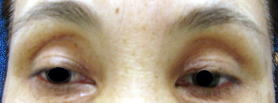
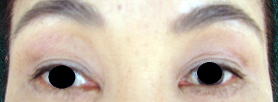
upper eyelid filler injection before after
downtime: puffy&tender for few days, if bruises observed, take around 1 wk.
This was all about bigger beautiful eyes and how to have them.
さらなる詳細 、 further details
Miyagi Cosmetic Surgery宮城美容外科クリニック
〒900-0016
沖縄県那覇市前島2−2−1(3F)
2-2-1-3F Maejima, Naha City
Okinawa, Japan 900-0016
TEL 098-860-9120
FAX 098-860-9176
※電話が混み合っている場合、ウェブやメールでの予約も受けております。オンライン予約はこちら
In case line is busy, please make reservations through our website or e-mail.
For online booking click here
e-mail miyagics@woody.ocn.ne.jp